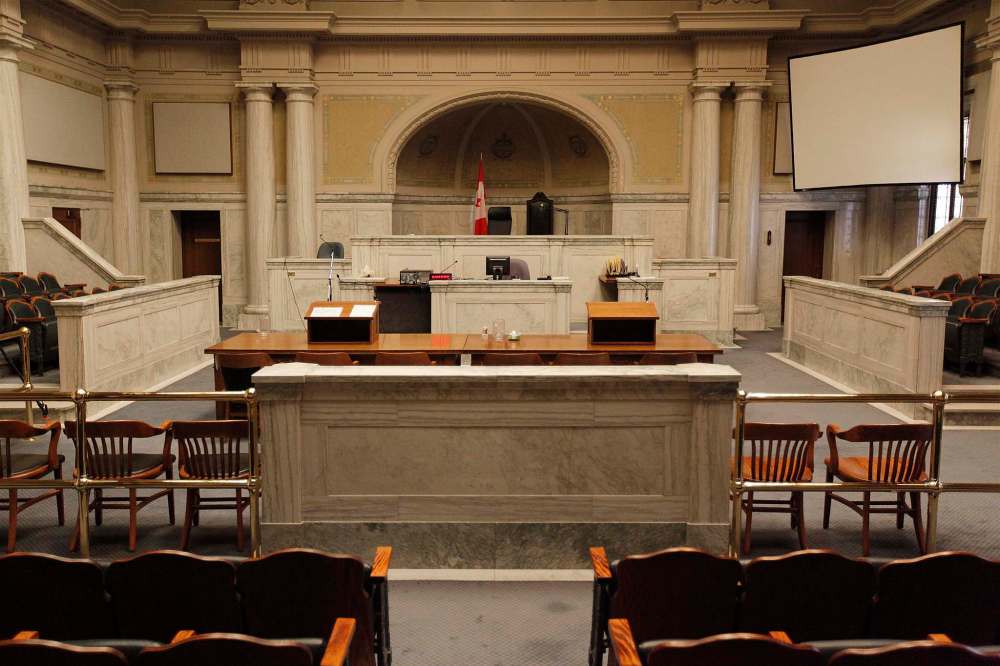One morning, two homicide trials, 150 potential jurors
Process to select a jury an education in civic obligation
Advertisement
Read this article for free:
or
Already have an account? Log in here »
To continue reading, please subscribe:
Monthly Digital Subscription
$0 for the first 4 weeks*
- Enjoy unlimited reading on winnipegfreepress.com
- Read the E-Edition, our digital replica newspaper
- Access News Break, our award-winning app
- Play interactive puzzles
*No charge for 4 weeks then price increases to the regular rate of $19.00 plus GST every four weeks. Offer available to new and qualified returning subscribers only. Cancel any time.
Monthly Digital Subscription
$4.75/week*
- Enjoy unlimited reading on winnipegfreepress.com
- Read the E-Edition, our digital replica newspaper
- Access News Break, our award-winning app
- Play interactive puzzles
*Billed as $19 plus GST every four weeks. Cancel any time.
To continue reading, please subscribe:
Add Free Press access to your Brandon Sun subscription for only an additional
$1 for the first 4 weeks*
*Your next subscription payment will increase by $1.00 and you will be charged $16.99 plus GST for four weeks. After four weeks, your payment will increase to $23.99 plus GST every four weeks.
Read unlimited articles for free today:
or
Already have an account? Log in here »
Hey there, time traveller!
This article was published 12/01/2019 (2529 days ago), so information in it may no longer be current.
The lineup snaked out the downtown Winnipeg Law Courts Building doors almost to Kennedy Street. We were here on a surprisingly balmy January morning, awaiting our fate at jury selection, or to visit the probate office, divorce court or to file any manner of documents.
First up, screening by the sheriff’s officers who operate the body scanners and X-ray machines.
“Do you have a laptop in here?” one asks.

“No.” I did not.
“Just like the airport,” another person in line quips.
In the 34 years since reaching the age of majority, nobody in my personal circle of influence had been summoned to jury duty. Today was my day. The letter arrived in late October.
After we all file into Courtroom 210, we’re greeted with a few courtesy announcements.
“We’ll be starting in 15 minutes,” a court officer says, “so if you have to use the bathroom, use it now, because the doors will be sealed once the court begins.”
Half the group heeds the warning, hence the next lineup. There’s a reason: there are nearly 150 people here, after 1,500 summonses were mailed out.
Taking pity, and perhaps sensing the process may take longer than they thought, officers open up the jury room and let some people use its washrooms.
Once everyone is back, the jury manager announces we have to leave the courtroom. Apparently, there were procedural questions to answer that would taint jurors.
Two trials, 24 jurors and four alternates: both cases are for homicide.
The first, set to begin Jan. 21, is for Brian Kyle Thomas, accused of killing Winnipeg Transit bus driver Irvine Jubal Fraser in February 2017.
The second, starting Jan. 7, has a pair of defendants, Jason Michael Meilleur and Christopher Matthew Brass, who face manslaughter charges in the killing of Jeanenne Chantel Fontaine in March 2017.
A Manitoba resident’s journey to the jury box begins in August, when the jury office requests blocks of health-card numbers from Manitoba Health.
The process is random, but basically, if you have a Manitoba health card, you could be chosen for jury duty. Summons are generated by picking those numbers randomly and then correlating the number with the holder.
There’s a list of reasons to be excluded from initial consideration: being a member of Parliament or a member of the legislative assembly, having almost any job related to the justice department, including being a sheriff, corrections officer or even just an employee of Manitoba Justice. Police, convicts, those with mental infirmities and those who cannot understand the language in use at trial are also among those excluded.
Everyone else had better show up.
We’re told to arrive at 9 a.m., with selection to start at 10 a.m. The reason being, regularly, at least one person fails to show up. This day is no exception, the panel is two short. Sheriff’s officers are issued to arrest them. Yes, handcuffs and all.
“The worst case was a pharmacist who put out hands for a prescription and, ‘Here are your cuffs, let’s go,’” jury manager James Krilyk says.
A shortly time later, our panel — those arriving to be considered as jurors form what’s called a jury panel — is full.
Once the accused has been arraigned — his or her charges read in court — the process begins. We have all been assigned juror numbers, and those numbers go into a box for a random drawing until 18 candidates have been selected.
“Before we begin,” says presiding Justice Richard Saull, just before the first number is called, “I just want to tell you people have tried all sorts of things to try to get out of jury duty. They don’t work.”
There’s a nervous chuckle from the gallery as the clerk draws the first number.
“Juror 136, please come forward,” the court clerk reads. As potential jurors reach the jury box, all are asked if they have something they’d like to tell the judge. A few do; many don’t.
Still, some people try.
My number was called in the first trial, set to run from Jan. 21 to Feb. 1.
My son and I are going to the Vegas Shoot indoor archery tournament in Las Vegas. Pre-paid travel arrangements are one of few excuses that work.
“Out of an abundance of caution,” I tell Saull, “I just want to let you know we leave on pre-paid travel Feb. 7.”
Saull confers with both the defence and Crown attorneys, and seems confident the trial will not go long. I thank him and take a seat in the back row of the jury box, 15th of 18 chosen, initially.

As the process goes on, some people approach the microphone to plead their case to the judge. One fellow is unemployed, with mounting child-care bills. He needs to finish his exams and find work, he says.
For his and similar cases, Saull stands them down, which means they return to the gallery but their number is retained, just in case.
It turns out, for only two trials, 150 potential jurors is “a very healthy panel,” Saull says. It’s often only 48 panelists for each jury of 12, but two of the trials for which this panel was assembled have either been resolved or postponed.
For the Fontaine case, one woman, a teacher in the North End, comes to the microphone. “I knew the victim,” she tells the court.
Such a personal connection to a case is grounds for immediate exclusion. Still, Saull is required to confer with counsel on both sides. “You’re excused,” he says. “You’re free to leave.”
Knowing any of the witnesses is also grounds for exclusion, so that list is read prior to selection.
Once the box of 18 is full, the court clerk instructs each, in order, to stand and face the accused. It’s a pillar of Canada’s justice system that the accused gets to face each juror.
After a few moments, the Crown attorney and defence counsel weigh in.
“Content, m’lord.”
“Content, m’lord.”
That person is now a juror.
“Challenge, m’lord,” utters either the Crown or the defence. If either says “challenge,” that person is removed from consideration for that trial. If there’s another selection process that day, the panelist returns to the gallery.
Each side gets 14 peremptory challenges (21 for first-degree murder trials), or opportunities to exclude jury panelists for any reason. None is given.
“It’s important to know that a challenge is not a reflection on your character, reputation or integrity,” Krilyk tells us before selection begins. Perhaps jokingly, he adds: “I’ve had counsel say they aren’t choosing anyone wearing red that day. And they don’t.”
I’m in the 15th seat, and when my turn comes, the Crown uses one of its challenges.
I return to my seat in the gallery: there’s a chance my number will be drawn again for the second selection. Indeed, at least four people had lightning strike twice.
No reason is given, but I speculate it’s my career as a journalist. Or maybe because I was wearing blue. I’ll never know.
Sometimes, counsel on either side will have identified others in later-filled seats they’d rather select, for any number of reasons, and simply want to minimize the threat of the jury being full before those others are chosen.
For both trials, the number of challenges plus the number of jurors chosen exceeds the 18 chosen initially, so the clerk calls more until the box of 18 is full again.
After a few more rounds of counsel saying “content, m’lord” or “challenge, m’lord,” the slate of 12 jurors and two alternates is chosen.
The process is repeated for the second trial’s selection, and less than four hours after we started, both jury panels are full.
I’m not on either of them.
kelly.taylor@freepress.mb.ca

Our newsroom depends on a growing audience of readers to power our journalism. If you are not a paid reader, please consider becoming a subscriber.
Our newsroom depends on its audience of readers to power our journalism. Thank you for your support.


